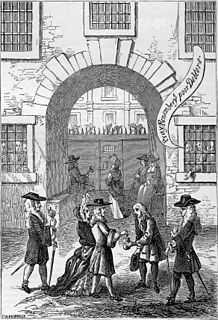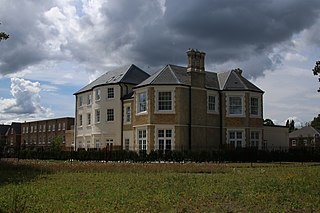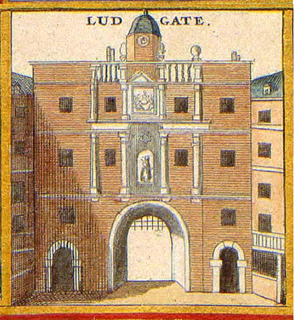 W
WBridewell Palace in London was built as a residence of King Henry VIII and was one of his homes early in his reign for eight years. Given to the City of London Corporation by his son King Edward VI for use as an orphanage and place of correction for wayward women, Bridewell later became the first prison/poorhouse to have an appointed doctor. It was built on the banks of the Fleet River in the City of London between Fleet Street and the River Thames in an area today known as Bridewell Place, off New Bridge Street. By 1556 part of it had become a jail known as Bridewell Prison. It was reinvented with lodgings and was closed in 1855 and the buildings demolished in 1863–1864.
 W
WClerkenwell Bridewell was a prison and correctional institute for prostitutes and vagrants located in the Clerkenwell area, immediately north of the City of London, between c.1615 and 1794, when it was superseded by the nearby Coldbath Fields Prison in Mount Pleasant. It was named 'Bridewell' after the Bridewell Palace, which during the 16th century had become one of the City of London's most important prisons.
 W
WClerkenwell (old) Prison, also known as the Clerkenwell House of Detention or Middlesex House of Detention was a prison in Clerkenwell, London, opened in 1847. It held prisoners awaiting trial.
 W
WThe Clink was a prison in Southwark, England, which operated from the 12th century until 1780. The prison served the Liberty of the Clink, a local manor area owned by the Bishop of Winchester rather than by the reigning monarch. As the Liberty owner, the Bishop kept all revenues from the Clink Liberty, and could put people in prison for failing to make their payments. As the Bishop, he could also imprison heretics. The Clink prison was situated next to the Bishop's London-area residence of Winchester Palace. The Clink was possibly the oldest men's prison and probably the oldest women's prison in England.
 W
WColdbath Fields Prison, also formerly known as the Middlesex House of Correction and Clerkenwell Gaol and informally known as the Steel, was a prison in the Mount Pleasant area of Clerkenwell, London. Founded in the reign of James I (1603–1625) it was completely rebuilt in 1794 and extended in 1850. It housed prisoners on short sentences of up to two years. Blocks emerged to segregate felons, misdemeanants and vagrants.
 W
WFleet Prison was a notorious London prison by the side of the River Fleet. The prison was built in 1197, was rebuilt several times, and was in use until 1844. It was demolished in 1846.
 W
WFulham Refuge, also known as Fulham Reformatory, was a women's prison in Fulham in west London that opened in 1856 and closed in 1888. The prison was intended to provide skills for prisoners to help rehabilitate them on their release back into the community.
 W
WGatehouse Prison was a prison in Westminster, built in 1370 as the gatehouse of Westminster Abbey. It was first used as a prison by the Abbot, a powerful churchman who held considerable power over the precincts and sanctuary. It was one of the prisons which supplied the Old Bailey with information on former prisoners for making indictments against criminals
 W
WThe Giltspur Street Compter was a compter or small prison, designed by English architect and surveyor George Dance the Younger, mainly used to hold debtors. It was situated in Giltspur Street, Smithfield, close to Newgate, in the City of London, between 1791 and 1853.
 W
WThe King's Bench Prison was a prison in Southwark, south London, England, from medieval times until it closed in 1880. It took its name from the King's Bench court of law in which cases of defamation, bankruptcy and other misdemeanours were heard; as such, the prison was often used as a debtor's prison until the practice was abolished in the 1860s. In 1842, it was renamed the Queen's Bench Prison, and became the Southwark Convict Prison in 1872.
 W
WLatchmere House is a building and grounds south-east of Ham Common in Ham, in the London Borough of Richmond upon Thames, in south west London, England. The southern part of the site lies in the Royal Borough of Kingston upon Thames.
 W
WLudgate was the westernmost gate in London Wall. The name survives in Ludgate Hill, an eastward continuation of Fleet Street, Ludgate Circus and Ludgate Square.
 W
WThe Marshalsea (1373–1842) was a notorious prison in Southwark, just south of the River Thames. Although it housed a variety of prisoners, including men accused of crimes at sea and political figures charged with sedition, it became known, in particular, for its incarceration of the poorest of London's debtors. Over half the population of England's prisoners in the 18th century were in jail because of debt.
 W
WMillbank Prison or Millbank Penitentiary was a prison in Millbank, Westminster, London, originally constructed as the National Penitentiary, and which for part of its history served as a holding facility for convicted prisoners before they were transported to Australia. It was opened in 1816 and closed in 1890.
 W
WIn July 1827, the inmates of the King's Bench Prison, a debtors' prison, in Borough, South London, devised an amusement to pass the time which gained the attention of the general public. It was proposed that they should elect a member to represent "Tenterden" in Parliament. Three candidates were put up, one of whom was Lieutenant Meredith, an eccentric naval officer.... As I approached the unfortunate, but merry, crowd, to the last day of my life I shall ever remember the impression... baronets and bankers, authors and merchants, painters and poets... dandies of no rank in rap and tat-ters... all mingled in indiscriminate merriment, with a spiked wall, twenty feet high, above their heads...
 W
WThe New Prison was a prison located in the Clerkenwell area of central London between c.1617 and 1877. The New Prison was used to house prisoners committed for examination before the police magistrates, for trial at the sessions, for want of bail, and occasionally on summary conviction.
 W
WNewgate Prison was a prison at the corner of Newgate Street and Old Bailey Street just inside the City of London, England, originally at the site of Newgate, a gate in the Roman London Wall. Built in the 12th century and demolished in 1904, the prison was extended and rebuilt many times, and remained in use for over 700 years, from 1188 to 1902.
 W
WThe Palace of Placentia, also known as Greenwich Palace, was an English royal residence that was initially built by Humphrey, Duke of Gloucester, in 1443. It was located at Greenwich on the bank of the River Thames, downstream from London. The original residence was extensively rebuilt around 1500 by Henry VII. In 1660, it was demolished by Charles II to make way for a proposed new palace, which was never constructed. Nearly forty years later, the Greenwich Hospital was built on the site.
 W
WPoultry Compter was a small prison that stood at Poultry, part of Cheapside in the City of London. The compter was used to lock up minor criminals and prisoners convicted under civil law and was run by the City's Sheriff. It operated from the 16th century until 1815. It was pulled down in 1817 and replaced with a chapel.
 W
WTothill Fields Bridewell was a prison located in the Westminster area of central London between 1618 and 1884. It was named "Bridewell" after the Bridewell Palace, which during the 16th century had become one of the City of London's most important prisons. Tothill Fields later became the Westminster House of Correction.
 W
WThe Tower of London, officially Her Majesty's Royal Palace and Fortress of the Tower of London, is a historic castle on the north bank of the River Thames in central London. It lies within the London Borough of Tower Hamlets, which is separated from the eastern edge of the square mile of the City of London by the open space known as Tower Hill. It was founded towards the end of 1066 as part of the Norman Conquest. The White Tower, which gives the entire castle its name, was built by William the Conqueror in 1078 and was a resented symbol of oppression, inflicted upon London by the new ruling elite. The castle was also used as a prison from 1100 until 1952, although that was not its primary purpose. A grand palace early in its history, it served as a royal residence. As a whole, the Tower is a complex of several buildings set within two concentric rings of defensive walls and a moat. There were several phases of expansion, mainly under kings Richard I, Henry III, and Edward I in the 12th and 13th centuries. The general layout established by the late 13th century remains despite later activity on the site.
 W
WWhitecross Street Prison was a debtors' prison in London, England. It was built between 1813–15 to ease overcrowding at Newgate Prison and closed in 1870, when all of the prisoners were transferred to the newly built Holloway Prison.
 W
WThe Wood Street Compter was a small prison within the City of London in England. It was primarily a debtors' prison, and also held people accused of such misdemeanours as public drunkenness, although some wealthier prisoners were able to obtain alcohol through bribery. The prison was built and opened in 1555, replacing the earlier Bread Street Compter, from which many prisoners were transferred. Wood Street was closed and replaced by Giltspur Street Compter in 1791.
 W
W